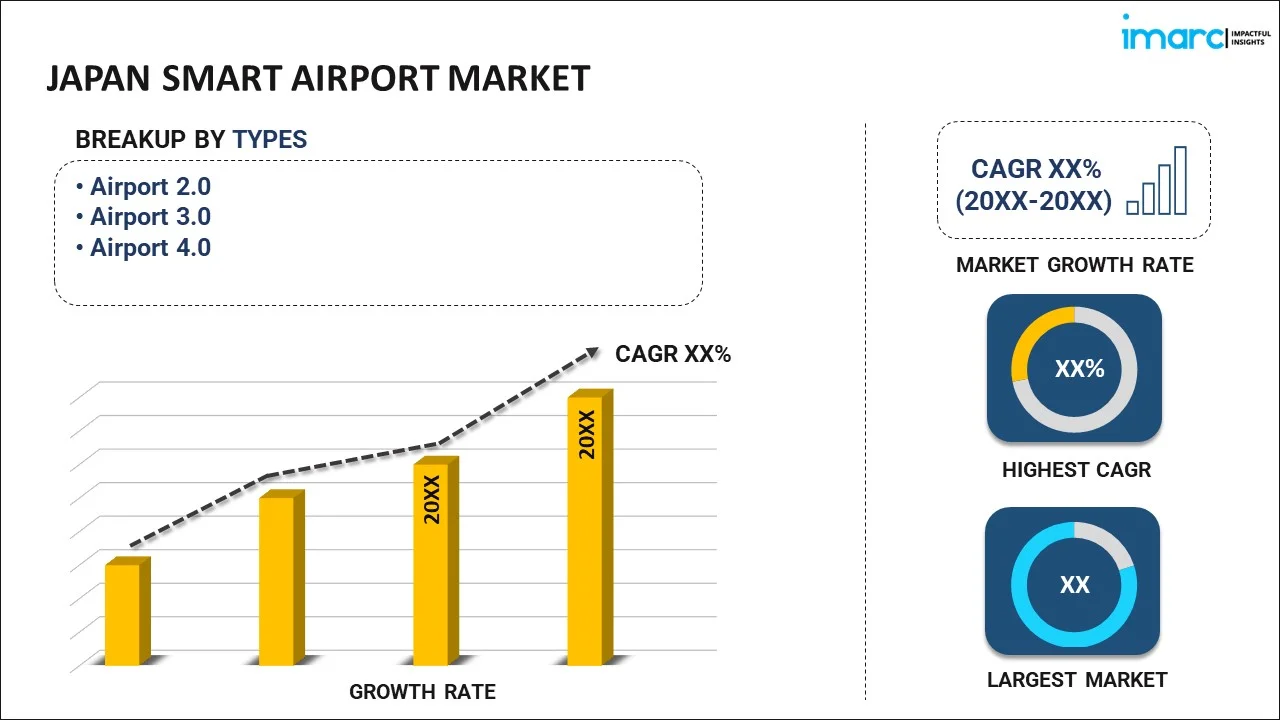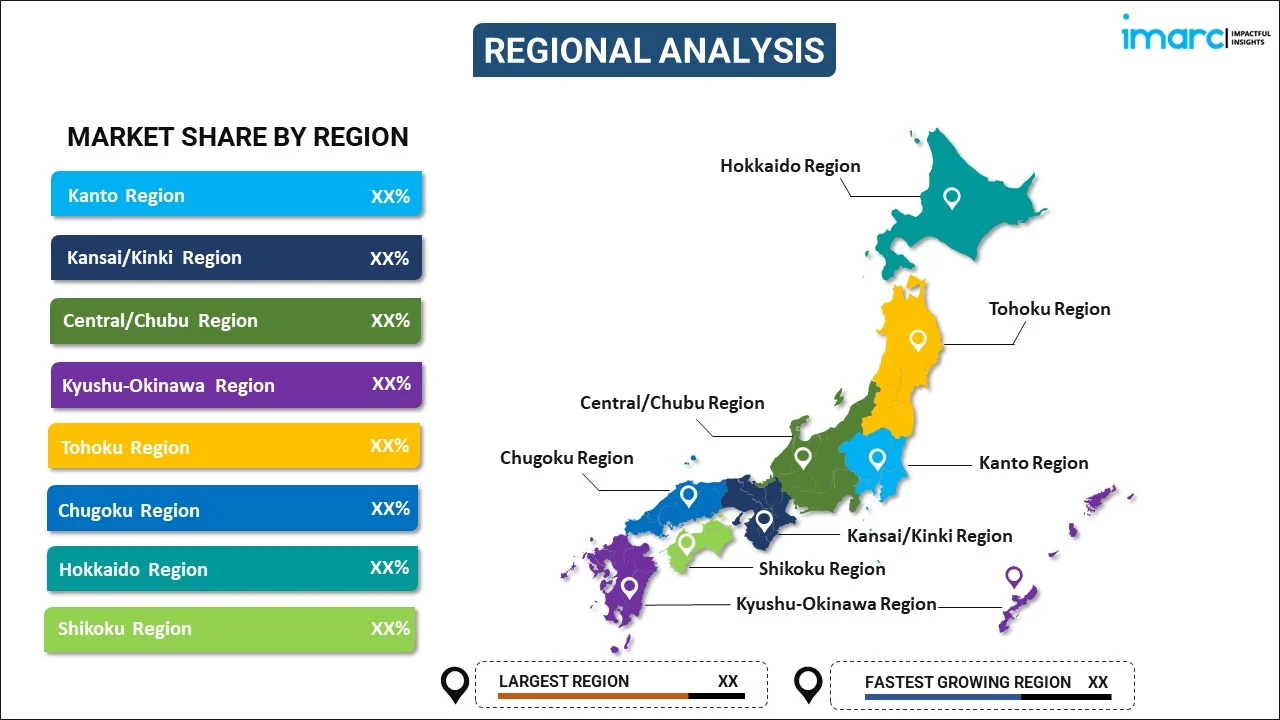
Japan Smart Airport Market Report by Type (Airport 2.0, Airport 3.0, Airport 4.0), Size (Large, Medium, Small), System (Wearables, LPWAN and WLAN, Tags and Sensors, Platforms, NFC, RFID and Bluetooth, Wireless, and Others), Operation (Aeronautical, Non-Aeronautical), End Market (Implementation, Upgrade and Services), Application (Airside, Air Traffic Maintenance, Aircraft Maintenance, Passenger Screening and Experience, Digital, Video, Surveillance and Management, Building Management, Intelligent Advertising, and Others), and Region 2025-2033
Market Overview:
Japan smart airport market size reached USD 2,253 Million in 2024. Looking forward, IMARC Group expects the market to reach USD 6,180.1 Million by 2033, exhibiting a growth rate (CAGR) of 11.9% during 2025-2033. The rising air travel demand, favorable government initiatives, significant technological advancements, influx of international tourists enhanced passenger experience and security measures, and increasing number of collaborations with airlines represent some of the key factors driving the market.
|
Report Attribute
|
Key Statistics
|
|---|---|
|
Base Year
|
2024 |
|
Forecast Years
|
2025-2033 |
|
Historical Years
|
2019-2024
|
| Market Size in 2024 | USD 2,253 Million |
| Market Forecast in 2033 | USD 6,180.1 Million |
| Market Growth Rate (2025-2033) | 11.9% |
A smart airport is an advanced and technologically integrated aviation facility designed to enhance the overall passenger experience, streamline operations, and improve efficiency. These airports leverage cutting-edge technologies, such as Internet of Things (IoT), artificial intelligence (AI), and data analytics, to optimize various aspects of airport management. Smart airports aim to provide passengers with a seamless journey, from check-in to boarding, by offering features like self-service kiosks, automated baggage handling, and real-time flight updates through mobile apps. Furthermore, these airports focus on sustainability and environmental considerations by implementing energy-efficient infrastructure and eco-friendly practices. These initiatives reduce the carbon footprint of the airport and also contribute to long-term cost savings.
Japan Smart Airport Market Trends:
Japan is a major international travel hub, and the demand for air travel continues to rise steadily. The increasing number of passengers requires airports to adopt smart technologies to handle the growing influx efficiently. As a result, smart airports in Japan are designed to optimize various processes, from baggage handling to security checks. Automation and data analytics are leveraged to reduce delays and improve the overall efficiency of airport operation. Other than this, a major factor driving the market is the desire to offer passengers a seamless journey by providing self-service kiosks, mobile check-in options, and personalized services to enhance their travel experience. Besides this, smart airports in Japan deploy advanced surveillance systems, biometrics, and AI-driven threat detection to ensure the safety and security of passengers and airport facilities. In line with this, Japanese airports, including Narita and Haneda, are major international gateways. To remain competitive on the global stage, these airports are continually upgrading their infrastructure to meet the evolving expectations of international travelers. Furthermore, airlines operating in Japan are increasingly partnering with airports to enhance the passenger experience. This collaboration often involves the implementation of technology-driven solutions that benefit both travelers and airlines. Apart from these factors, Japan is known for its innovation and technological progress. The airports in the region are quick to adopt cutting-edge technologies, including biometric authentication, IoT, and AI, to enhance operational efficiency and passenger services. Moreover, the popularity of Japan as a tourist destination continues to surge. Smart airports cater to the influx of international tourists by providing multilingual assistance, cultural experiences, and efficient immigration processes. The COVID-19 pandemic highlighted the importance of contactless solutions and health measures at airports. Smart airports in Japan have adapted to address these concerns, with touchless check-in, health screenings, and sanitation protocols. These factors are expected to create a favorable market outlook in the upcoming years.
Japan Smart Airport Market Segmentation:
IMARC Group provides an analysis of the key trends in each segment of the market, along with forecasts at the country level for 2025-2033. our report has categorized the market based on type, size, system, operation, end market, and application.
Type Insights:

- Airport 2.0
- Airport 3.0
- Airport 4.0
The report has provided a detailed breakup and analysis of the market based on the type. This includes airport 2.0, airport 3.0, and airport 4.0.
Size Insights:
- Large
- Medium
- Small
A detailed breakup and analysis of the market based on the size have also been provided in the report. This includes large, medium, and small.
System Insights:
- Wearables
- LPWAN and WLAN
- Tags and Sensors
- Platforms
- NFC, RFID and Bluetooth
- Wireless
- Others
The report has provided a detailed breakup and analysis of the market based on the system. This includes wearables, LPWAN and WLAN, tags and sensors, platforms, NFC, RFID and bluetooth, wireless, and others.
Operation Insights:
- Aeronautical
- Non-Aeronautical
A detailed breakup and analysis of the market based on the operation have also been provided in the report. This includes aeronautical and non-aeronautical.
End Market Insights:
- Implementation
- Upgrade and Services
The report has provided a detailed breakup and analysis of the market based on end market. This includes implementation and upgrade and services.
Application Insights:
- Airside
- Air Traffic Maintenance
- Aircraft Maintenance
- Passenger Screening and Experience
- Digital Video Surveillance and Management
- Building Management
- Intelligent Advertising
- Others
A detailed breakup and analysis of the market based on the application have also been provided in the report. This includes airside, air traffic maintenance, aircraft maintenance, passenger screening and experience, digital, video, surveillance and management, building management, intelligent advertising, and others.
Regional Insights:

- Kanto Region
- Kansai/Kinki Region
- Central/ Chubu Region
- Kyushu-Okinawa Region
- Tohoku Region
- Chugoku Region
- Hokkaido Region
- Shikoku Region
The report has also provided a comprehensive analysis of all the major regional markets, which include Kanto Region, Kansai/Kinki Region, Central/ Chubu Region, Kyushu-Okinawa Region, Tohoku Region, Chugoku Region, Hokkaido Region, and Shikoku Region.
Competitive Landscape:
The market research report has also provided a comprehensive analysis of the competitive landscape. Competitive analysis such as market structure, key player positioning, top winning strategies, competitive dashboard, and company evaluation quadrant has been covered in the report. Also, detailed profiles of all major companies have been provided.
Japan Smart Airport Market Report Coverage:
| Report Features | Details |
|---|---|
| Base Year of the Analysis | 2024 |
| Historical Period | 2019-2024 |
| Forecast Period | 2025-2033 |
| Units | Million USD |
| Scope of the Report | Exploration of Historical and Forecast Trends, Industry Catalysts and Challenges, Segment-Wise Historical and Predictive Market Assessment:
|
| Types Covered | Airport 2.0, Airport 3.0, Airport 4.0 |
| Sizes Covered | Large, Medium, Small |
| Systems Covered | Wearables, LPWAN and WLAN, Tags and Sensors, Platforms, NFC, RFID and Bluetooth, Wireless, Others |
| Operations Covered | Aeronautical, Non-Aeronautical |
| End Markets Covered | Implementation, Upgrade and Services |
| Applications Covered | Airside, Air Traffic Maintenance, Aircraft Maintenance, Passenger Screening and Experience, Digital, Video, Surveillance and Management, Building Management, Intelligent Advertising, Others |
| Regions Covered | Kanto Region, Kansai/Kinki Region, Central/ Chubu Region, Kyushu-Okinawa Region, Tohoku Region, Chugoku Region, Hokkaido Region, Shikoku Region |
| Customization Scope | 10% Free Customization |
| Post-Sale Analyst Support | 10-12 Weeks |
| Delivery Format | PDF and Excel through Email (We can also provide the editable version of the report in PPT/Word format on special request) |
Key Questions Answered in This Report:
- How has the Japan smart airport market performed so far and how will it perform in the coming years?
- What has been the impact of COVID-19 on the Japan smart airport market?
- What is the breakup of the Japan smart airport market on the basis of type?
- What is the breakup of the Japan smart airport market on the basis of size?
- What is the breakup of the Japan smart airport market on the basis of system?
- What is the breakup of the Japan smart airport market on the basis of operation?
- What is the breakup of the Japan smart airport market on the basis of end market?
- What is the breakup of the Japan smart airport market on the basis of application?
- What are the various stages in the value chain of the Japan smart airport market?
- What are the key driving factors and challenges in the Japan smart airport?
- What is the structure of the Japan smart airport market and who are the key players?
- What is the degree of competition in the Japan smart airport market?
Key Benefits for Stakeholders:
- IMARC’s industry report offers a comprehensive quantitative analysis of various market segments, historical and current market trends, market forecasts, and dynamics of the Japan smart airport market from 2019-2033.
- The research report provides the latest information on the market drivers, challenges, and opportunities in the Japan smart airport market.
- Porter's five forces analysis assist stakeholders in assessing the impact of new entrants, competitive rivalry, supplier power, buyer power, and the threat of substitution. It helps stakeholders to analyze the level of competition within the Japan smart airport industry and its attractiveness.
- Competitive landscape allows stakeholders to understand their competitive environment and provides an insight into the current positions of key players in the market.
Need more help?
- Speak to our experienced analysts for insights on the current market scenarios.
- Include additional segments and countries to customize the report as per your requirement.
- Gain an unparalleled competitive advantage in your domain by understanding how to utilize the report and positively impacting your operations and revenue.
- For further assistance, please connect with our analysts.
 Inquire Before Buying
Inquire Before Buying
 Speak to an Analyst
Speak to an Analyst
 Request Brochure
Request Brochure
 Request Customization
Request Customization




.webp)




.webp)












